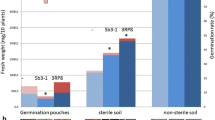Abstract
The ability of Pythium irregulare, P. sylvaticum and P. ultimum var. ultimum to induce damping-off of lucerne (Medicago sativa) seedlings cv. SA Standard was tested in artificially infested planting medium. Three levels of sand-bran inoculum were used: 5, 25 and 50 g inoculum per kg planting medium. All the Pythium species caused more than 80% damping-off at each inoculum level and are therefore pathogenic to lucerne. There were differences in virulence among the species and isolates tested. Pythium sylvaticum was the most virulent while P. irregulare was the least virulent species tested. The highest survival rates in inoculated soil were recorded for seedlings growing in soil containing the lowest levels of inoculum for each species tested. At the high inoculum levels (25 and 50 gkg) in some cases (P, sylvaticum and P. ultimum var. ultimum) survival was so low that intra-species differences in virulence could no longer be detected. Since there were differences in virulence among the species and isolates tested, it is important to test a number of isolates of a species before drawing conclusions about the pathogenicity of the species as a whole to a particular host, and to select appropriate levels of inoculum to elucidate these differences. As far as could be determined this is the first valid report of P. sylvaticum as a pathogen of lucerne seedlings.
Similar content being viewed by others
References
Bucholtz, W.F. (1942) — Influence of cultural factors on alfalfa seedling infection by Pythium debalyanum Hesse. Iowa AgriculturalExperiment Station Research Bulletin No. 296.
Chen, W. and Lipps, P.E. (1993) — Intraspecific genetic variation in Pythium arrhenomanes from a corn field. Abstract Proceedings of the Sixth International Congress of Plant Pathology, Montreal, Canada.
Denman, S., Knox-Davies, P.S. and Ali-Shtayeh, M.S. (1992) — Identification of Pythium isolates associated with damped-off lucerne seedlings in South Africa. Phytophylactica 24: 329–334.
Halpin, J.E. and Hanson, E.N. (1958) — Effect of age of seedlings of alfalfa, red clover, ladino clover, white clover and sweet clover on susceptibility to Pythium. Phytopathology 48: 481–485.
Halpin, J.E., Hanson, E.N. and Dickson, J.G. (1952) — Studies on the pathogenicity of seven species of Pythium on red clover seedlings. Phytopathology 42: 245–249.
Halpin, J.E., Hanson, E.N. and Dickson, J.G. (1954) — Studies on the pathogenicity of seven species of Pythium on alfalfa, red clover and ladino clover seedlings. Phytopathology 44: 572–574.
Hancock, J.G. (1983) — Seedling diseases of alfalfa in California. Plant Disease 67: 1203–1208.
Hancock, J.G. (1985) — Fungal infection of feeder rootlets of alfalfa. Phytopathology 75: 1112–1120.
Hancock, J.G. (1991) — Seedling and rootlet diseases of forage alfalfa caused by Pythium irregulare. Plant Disease 75: 691–694.
Hancock, J.G. (1993) — Fungal rootlet colonization and forage yields of alfalfa in fungicide-treated fieldplots. Plant Disease 77: 601–608.
Lamprecht, S.C. (1986) — A new disease of Medicago truncatula caused by Cylindrocladium scoparium. Phytophylactica 18: 111–114.
Lamprecht, S.C. and Knox-Davies, P.S. (1984) — Stemphylium vesicarium on lucerne (Medicago sativa) seeds in South Africa. Phytophylactica 16: 189–193.
Lamprecht, S.C., Knox-Davies, P.S. and Marasas, W.F.O. (1988) — Fungi associated with root rot of annual Medicago spp. in South Africa. Phytophylactica 20: 281–286.
Schmitthenner, A.F. (1964) — Prevalence and virulence of Phytophthora, Aphanomyces, Pythium, Rhizoctonia and Fusarium isolated from diseased alfalfa seedlings. Phytopathology 54: 1012–1018.
Schmitthenner, A.F. and Hilty, J.W. (1962) — A method for studying post-emergence seedling rot. Phytopathology 52: 177–179.
Scott, D.B. (1987) — Identification and pathogenicity of Pythium isolates from wheatfield soil in South Africa. Phytophylactica 19: 499–504.
Snedecor, G.W. and Cochran, W.G. (1980) — Statistical Methods (7th edition). Iowa State University Press, Ames, Iowa.
Stelfox, D. and Williams, J.R. (1980) — Pythium species in alfalfa fields in central Alberta. Canadian Plant Disease Survey 60: 35–36.
Author information
Authors and Affiliations
Rights and permissions
About this article
Cite this article
Denmad, S., Knox-Davies, P.S., Calitz, F.J. et al. Pathogenicity of Pythium irregulare, P. sylvaticum and P. ultimum var. ultimum to lucerne (Medicago sativa). Australasian Plant Pathology 24, 137–143 (1995). https://doi.org/10.1071/APP9950137
Received:
Accepted:
Issue Date:
DOI: https://doi.org/10.1071/APP9950137




